Services on Demand
Journal
Article
Indicators
-
 Cited by SciELO
Cited by SciELO
Related links
-
 Similars in
SciELO
Similars in
SciELO  uBio
uBio
Share
Revista Peruana de Biología
On-line version ISSN 1727-9933
Rev. peru biol. vol.17 no.2 Lima Aug. 2010
Neotypification of Ceroxylon weberbaueri Burret
Neotipificación de Ceroxylon weberbaueri Burret
Jean-Christophe Pintaud1 ; Betty Millán2 and Francis Kahn3
1 IRD, UMR DIADE/DYNADIV, 911 Avenue Agropolis, BP 64501, 34394 Montpellier Cedex 5, France.
Email: jean-christophe.pintaud@ird.fr
2 Museo de Historia Natural, Universidad Nacional Mayor de San Marcos, Lima - Perú. Avda. Arenales 1256 Jesús María, Lima 14, Perú.
Email: bmillans@gmail.com
3 IRD, UMR-DIADE/DYNADIV, Casilla 18-1209, Lima, Perú.
Email: francis.kahn@ird.fr
Abstract
Ceroxylon weberbaueri Burret, a poorly known species, is recollected from its type locality. An amended description is provided and the species is neotypified.
Key words: botanical nomenclature, morphological description, neotype.
Resumen
Ceroxylon weberbaueri Burret, una especie poco conocida, ha sido recolectada en su localidad tipo. Se provee una descripción morfológica actualizada, y una neotipificación.
Palabras clave: descripción morfológica, neotipo, nomenclatura botánica.
The genus Ceroxylon, an Andean endemic taxon, comprises 6 species in Peru (Galeano et al. 2008, Pintaud et al. 2008). One of these, Ceroxylon weberbaeuri, was described on the basis of a single collection made by A. Weberbauer in 1902 in Puno region, very close to the boundary between Peru and Bolivia (Burret 1929). Although the species was accepted in recent literature (Henderson et al. 1995, Govaerts & Dransfield 2005), it remains poorly known. The original description is incomplete, lacks illustration and the type specimen was destroyed during the bombing of Herbarium Berolinense (B) during World War II. No isotype was found in the Weberbauer herbarium at MOL. The distribution of the species is not well known. It has been considered as a Peruvian endemic (Millán 2006), however it needs to be compared with Bolivian populations adjacent to the type locality. The report of this species in Cajamarca, in the north of Peru (Millán 2006), is probably due to a misidentification of Ceroxylon vogelianum specimens. On the other hand, some specimens reported as Ceroxylon parvum, C. vogelianum and C. pityrophyllum in south of Peru and north of Bolivia (Galeano 1995, Mueller et al. 2002) may represent Ceroxylon weberbaueri. As a first step to clarify this taxonomic confusion, we provide an amended description and a neotypification of Ceroxylon weberbaueri from its recently revisited type locality (Fig. 1).

Ceroxylon weberbaueri Burret
Notizbl. Bot. Gart. Berlin-Dahlem 10:848, 1929.
TYPE. Peru, Puno, between Tambo Yuncacocha and Tambo Cachicachi (road from Sandía to Chunchusmayo), 1800-2000 m, 8 June 1902, A. Weberbauer 1157 (holotype, B, destroyed).
NEOTYPE (here designated): PERU. Region Puno, Prov. Sandía, Dist. San Juan del Oro, loc. Siyacunga 14°14'18.8''S, 69°10'40.2"W, 1775 m, 23 March 2010, (stam. fl.), B. Millán & F. Kahn 1701 (Holoneotype, USM).
Medium-sized, solitary palms. Trunk 5-10 m tall, 12 cm diameter, greenish to grey. Leaves 12-25 forming a dense crown of glaucous-green color; sheath 41-65 cm long, petiole 43-105 cm long, rachis 134-162 cm long, sheath, petiole and rachis densely covered with a whitish appressed, persistent tomentum; pinnae 85-98 on each side of rachis, strongly grouped and arranged in different planes in the proximal 1/3 of rachis, regularly arranged in one plane in the distal part; adaxial surface glabrous, abaxial surface covered with an appressed indument, initially golden-brown, aging whitish, proximal pinnae 37-57cm long, 0.3-1 cm wide, middle pinnae 52-68 cm long, 2-3.2 cm wide, distal pinnae 26-42 cm long, 0.2-0.6 cm wide. Staminate inflorescence with prophyll 14 cm long, 12 cm wide; bracts 7, carinate and more or less rostrate, light-brown, 24-136 cm long, 14-16.5 cm wide; peduncle 71.5 cm long; rachis 52.5 cm long; 43 first order branches, basal and middle first order branches with 18-25 second order branches (14.5-21 cm long), distal first order branches with 1-2 second order branches (6.5-10 cm long). Pistillate inflorescence with prophyll 17 cm long, inserted 4.5 cm above the base of peduncle on adaxial side, first three peduncular bract complete, carinate, rostrate, 80-110 cm long, fourth peduncular bract tubular, tightly encircling peduncle, 50 cm long; peduncle 60-76 cm long and 7 cm wide at base, covered with a persistent brown indument; rachis and branches glabrous at fruit stage, rachis 45-55 cm long, with 44-45 first order branches (proximal 13 cm long, middle 21-22 cm long, distal 1-4 cm long); middle first order branches with 12-21 second order branches, these 1-6 cm long. Staminate flower with 3 sepals, these ovate, acuminate, 0.9-1.4 mm long, connate basally in 0.2-0.3 mm, not reaching the total length of corolla tube, petals 3, ovate to rhomboid, fleshy, 4.5-5.5 mm long including an acumen of 0.4-1 mm long, connate basally in 2-3 mm, stamens 6, conspicuously exserted from the petals, alternating 1 antisepalous stamen and 1 antipetalous stamen, filament tapered, 1.5-2 mm long, basally inflated and 0.4-1 mm thick, connected to anther at proximal 1/4-1/3 of its length, anthers 4.5-6.5 mm long, thecae separated in the proximal 1/4 of their length, connective not projected, pistillode trifid, 0.7 mm long. Pistillate flower not seen. Fruit obovoid to 2 cm high and 1.8 cm in diameter, often with abortive carpels visible and more or less developed, exocarp nearly smooth when fresh, red at maturity, dotted with lenticels, perianth with triangular petals, staminodes triangular, obtuse at apex, to 2 mm long, sometimes with abortive anther.
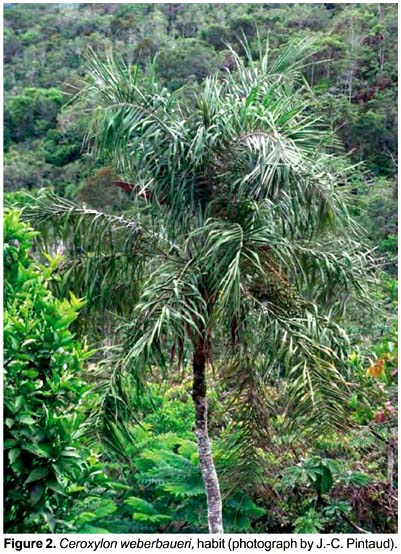
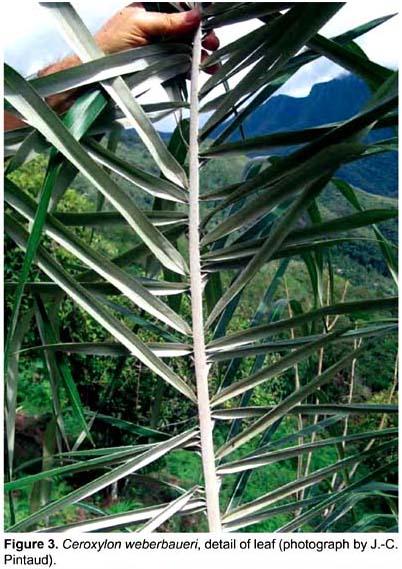
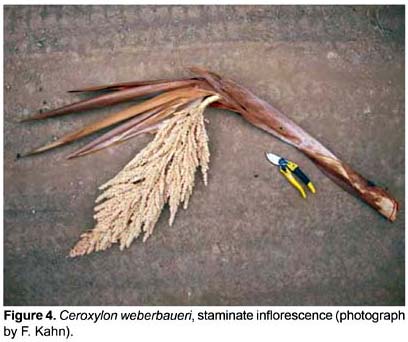
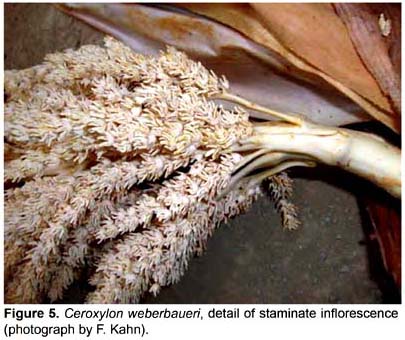
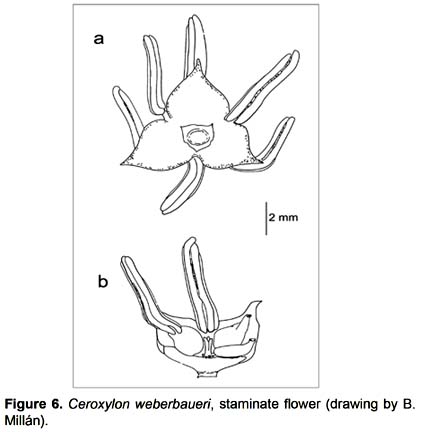
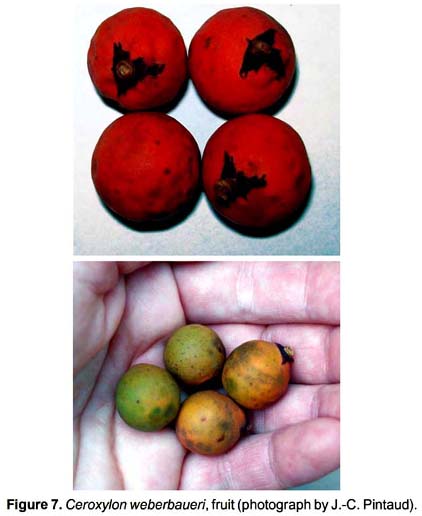
Additional material.- Peru, Puno, Prov. Sandia, Dist. San Juan del Oro, 14°14'19.1"S, 69°10'40.5"W, 1758 m, 10 Nov. 2009, (fr.), F. Kahn, J.-C. Pintaud, M. Machahua 4478 (USM).
Distribution and habitat.- The toponym Chunchusmayo on the label of the type specimen is still found on modern maps, located in the upper Tambopata valley (14°05'35"S, 68°58'0"W). On the road Sandia-Chunchusmayo followed by A. Weberbauer, Ceroxylon weberbaueri is found only above San Juan del Oro (Fig. 1), so we consider this place as being the type locality and the neotype was collected there. Ceroxylon weberbaueri is infrequent in the upper Tambopata and Iñambari mountains. It grows as isolated sub-canopy individuals in premontane humid to semi-deciduous forest from 1285 to 2100 m elevation.
Local name.- "Morona" (Sandia)
Uses.- Conserved in cultivated plots or even favored in coffee plantations under shade where it can be more abundant than in natural conditions. Products (trunk, leaves, fruits) generally not harvested.
Notes.- The species appears highly distinctive especially for the very large anthers that are prominently exserted at anthesis. In general habit, Ceroxylon weberbaueri is reminiscent of C. vogelianum for the small stature, slender, sometime flexuose trunk and short leaves with grouped segments spreading in different planes. Cexoxylon weberbaueri is however distinguished by its dense spherical crown that can include up to 25 leaves and the smooth fruits dotted with lenticels.
Acknowledgments
This work was done under the agreement between UNMSM/Universidad Nacional Mayor de San Marcos, Peru and IRD/Research Institute for Development (UMR DIADE/DYNADIV), France, and supported by the PALMS project funded by the European Community, 7th Framework Programme, Grant Agreement N°212631.
Literature cited
Burret M. 1929. Die Gattung Ceroxylon Humb. et Bonpl. Notizbl. Bot. Gart. Berlin-Dahlem 10: 841-853.
Govaerts R. & J. Drans?eld. 2005. World checklist of palms. Royal Botanic Gardens, Kew.
Galeano G. 1995. Novedades en el género Ceroxylon (Palmae). Caldasia 17(82-85): 395-408.
Galeano G., M.J. Sanín, K. Mejía, J.-C. Pintaud & B. Millán. 2008. Novelties in the genus Ceroxylon (Arecaceae) from Peru, with description of a new species. Revista Peruana de Biología 15 (supl. 1): 65-72.
Henderson A., G. Galeano & R. Bernal. 1995. Field guide to the palms of the Americas. Princeton University Press.
Millán B. 2006. Arecaceae endémicas del Perú. Rev. peru. biol. 13(2): 706s - 707s.
Mueller R., S.G. Beck & R. Lara. 2002. Potential vegetation based on climate-data in the Bolivian Yungas-forests. Ecología en Bolivia 37(2): 5-14.
Pintaud J.-C., G. Galeano, H. Balslev, R. Bernal, F. Borchsenius, E. Ferreira, J.-J. de Granville, K. Mejía, B. Millán, M. Moraes, L. Noblick, F.W. Stauffer & F. Kahn. 2008. The palms of South America: diversity, distribution and evolutionary history. Rev. peru. biol. 15 (supl. 1): 7-29.
Presentado: 24/04/2010
Aceptado: 23/07/2010
Publicado online: 14/12/2010













